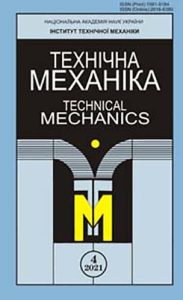Head of department – D.Sc., Professor Valentyn O. Shuvalov
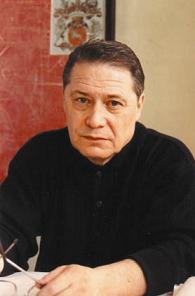
The department counts 15 employees, including 1 Doctor of Science and 3 PhDs.
Field of research – fundamental research on the mechanics of the interaction of a solid body with plasma flows, electromagnetic radiation, electric and magnetic fields in the atmosphere and in the Earth’s ionosphere.
Research methods – physical and numerical modeling of processes and phenomena characteristic of the interaction of a solid body (aircraft) with the surrounding environment in the Earth’s atmosphere.
A brief research history in the department
Department 4 – Department of Aerogas Dynamics of the Dnipropetrovsk branch of the Institute of Mechanics of the Academy of Sciences of the Ukrainian SSR was organized on June 10, 1966. The first head of the department was the Hero of Socialist Labor, corresponding member of the Academy of Sciences of the USSR and Academy of Sciences of the Ukrainian SSR, member of the International Academy of Astronautics, Doctor of Technical Sciences, Professor, laureate of the Lenin and State Prizes of the USSR, chief designer of KB-3 V. M. Kovtunenko.
In 1973, a laboratory of ionospheric aerodynamics was organized in the department, on the basis of which in 1987 the department of mechanics of ionized media of the Institute of Technical Mechanics of the Academy of Sciences of the Ukrainian SSR was created. Doctor of Technical Sciences, Professor V. O. Shuvalov became the head of the department.
The department is one of the world leaders in research in the field of “mechanics of the interaction of a solid body with plasma flows, electromagnetic radiation, electric and magnetic fields in the atmosphere and in the Earth’s ionosphere.”

The most important achievements of the department
A set of on-board scientific equipment for diagnosing ionospheric plasma has been developed – sensors of charged and neutral particles (electric cylindrical Langmuir probes, two-channel electric pressure probe). The equipment has been installed and operated on the Ukrainian space vehicles “Sich-2”, “Sich-2-30”. The equipment makes it possible to identify the localization of sources of ionospheric plasma disturbances caused by natural phenomena, man-made disasters and seismic activity on subsatellite tracks.
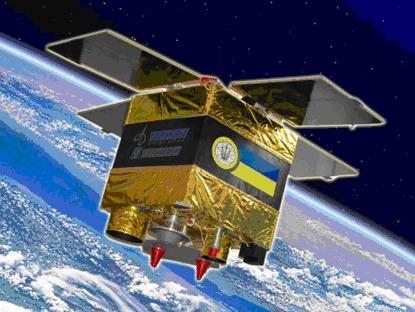
Scientific equipment developed and manufactured in Department 4 and installed on board the Ukrainian satellite “Sich-2-30”
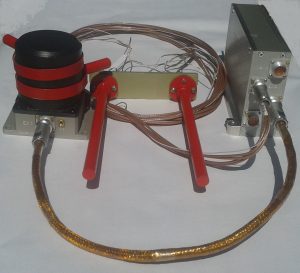
2 – sensor of charged particles
Within the framework of the international project RP 7 of the EU “Improving the safety of low Earth orbit using an improved electric rocket engine” (“LEOSWEEP” project FP7-SPA 2013.3.2-01, EUROPEAN COMMISSION 7th Framework Program for Research, technological, Development and Demonstration, concluded under the results of the victory in the FP7-SPACE-2013 competition of the European Union) to justify active methods and means of removing large fragments of space debris using intense ion and plasma jets, models of dynamic interaction of high-energy ions of plasma flows with structural materials of rocket and space technology products have been determined: the dependence of coefficients has been determined sputtering, momentum and energy accommodation coefficients from the type and kinetic energy of ions, from contact angles with the surface of materials, taking into account secondary emission and particle reflection.
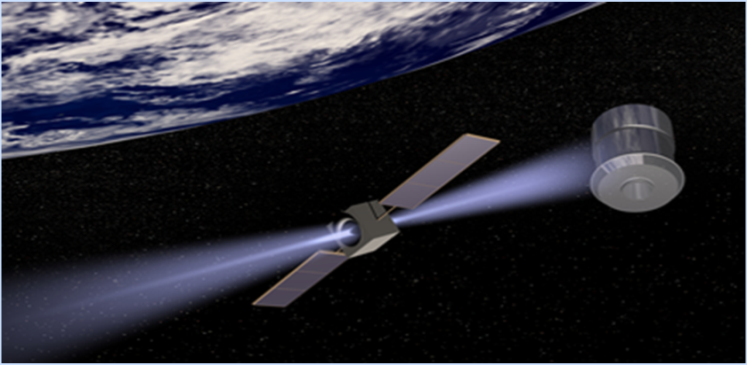 | 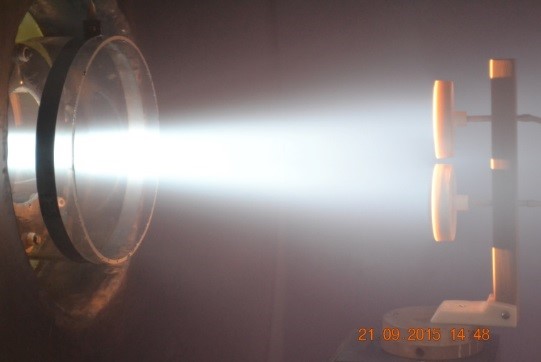 |
| Removal of fragments of space debris with the help of intense ion and plasma flows | Samples of materials in the plasma stream at the ITM stand |
Achievements in 2023
The peculiarities of interaction of structural polymers (Kapton-H, Teflon FEP-100A) with hypersonic flows of atomic oxygen and solar ultraviolet have been investigated for the first time under the conditions of physical modeling of the interaction between the outer surfaces of the space technology products with the environment in very low orbits (150 km – 300 km) on the plasmoelectrodynamic bench of the Institute of Technical Mechanics of the NAS and SSA of Ukraine. Determined parameters: roughness coefficient, integral solar energy absorption coefficient and their dependence on the energy and fluence of atomic oxygen ions. The obtained parameters characterize the rate of material degradation during their lifetime in the Earth’s atmosphere.
Current cooperation
A number of works and studies have been carried out and are conducted in cooperation with leading institutions of the aerospace industry, universities and academic institutes: State enterprise “M. K. Yangel “Yuzhnoye” Design Office, Lviv Center of the Institute of Space Research of the National Academy of Sciences of Ukraine and the Institute of Space Research of the National Academy of Sciences of Ukraine, Oles Honchar Dnipro National University, Ukrainian State University of Chemistry and Technology and others.
Experimental base
Experimental research is carried out on the ITM plasma-electrodynamic stand developed and created in the department, which was included in the State Register of scientific objects that are national property by Order of the Cabinet of Ministers of Ukraine dated August 28, 2013 No. 650.
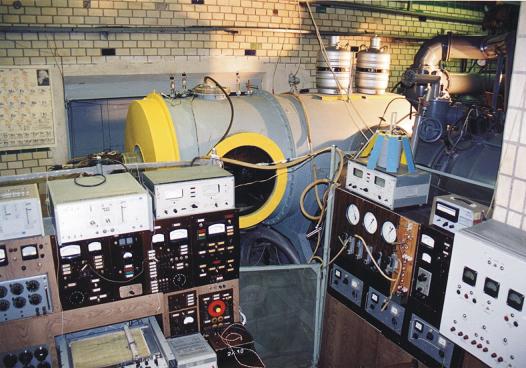
The stand is intended for the study of various aspects of the interaction of a solid body (including materials and structural elements of aircraft) with the environment in the Earth’s ionosphere and magnetosphere.
REFERENCES
MONOGRAPHS
V. A. Shuvalov. Modeling of the interaction of bodies with the ionosphere (In Russian). Kyiv: “Scientific opinion”, 1995. – 180 p.
MAIN PUBLICATIONS IN RECENT YEARS (indexed in Scopus, Web of Science databases)
- Drag on a spacecraft produced by the interaction of its magnetic field with the earth’s ionosphere. physical modelling / V. A. Shuvalov, N. B. Gorev, N. A. Tokmak, Y. P. Kuchugurnyi // Acta Astronautica (Elsevier). – 2019 (January 2020). – V. 166, P. 41 – 51. DOI: 10.1016/j.actaastro.2019.10.018
- Simulation of the physicochemical effect of atomic oxygen of the Earth’s ionosphere on polymers / V. A. Shuvalov, N. I. Pismennyi, N. P. Reznichenko, G. S. Kochubei // High Energy Chemistry (Pleiades Publishing – Springer Nature). – 2021. – V. 55, No. 1, P. 52 – 58. DOI: 10.1134/S0018143921010124
- Physical modeling of the impact of atomic oxygen of the Earth’s ionosphere on spacecraft polymers / V. A. Shuvalov, N. A. Tokmak, N. I. Pismennyi, G. S. Kochubei // Instruments and Experimental Techniques (Pleiades Publishing – Springer Nature). – 2021. – V. 64, No. 4. – Р. 570 – 579. DOI: 10.1134/S0020441221040102
- Electron saturation current on a cylindrical probe in a magnetized rarefied plasma flow / V. A. Shuvalov, Y. P. Kuchugurnyi, G. S. Kochubei, S. V. Nosikov // High Temperature (Pleiades Publishing – Springer Nature). – 2022. – V. 60, No. 1 – Р. 1 – 7. DOI: 10.1134/S0018151X22010230
- Probe diagnostics and identification of sources of ionospheric magnetized plasma perturbations / V. A. Shuvalov, N. I. Pis’mennyi, G. S. Kochubei, D. N. Lazuchenkov // Instruments and Experimental Techniques (Pleiades Publishing – Springer Nature). – 2022. – V. 65. – Р. 336 – 350. DOI: 10.1134/S002044122202018X
- Polyimide degradation under atomic oxygen attack / V. A. Shuvalov, N. B. Gorev, Y. P. Kuchugurnyi // Acta Astronautica (Elsevier). – 2023. – V. 207. – Р. 118 – 128. DOI: 10.1016/j.actaastro.2023.03.002 Scopus Scientific Database Quartile Q1
- Increasing the conversion accuracy of model gas (Ar) consumption into xenon consumption when using capillary tubes in the working substance feed systems of lectric propulsion / B. V. Yurkov, O. M. Petrenko, S. Yu. Asmolovskyi, D. K. Voronovskyi, S. M. Kulagin // Space Sci. & Technol. – 2023. – V. 29, № 5. P. 51 – 59. Scopus Scientific Database Quartile Q3
- Optimization of the accumulator tank filling modes of the xenon feed system for electric propulsion system / B. Yurkov, S. Asmolovskyi, V. Pererva, D. Voronovskyi, S. Kulagin // Eastern-European Journal of Enterprise Technologies. – 2023. – 5/2 (125). – P. 26 – 34. http://doi.org/10.15587/1729-4061.2023.287007 Scopus Scientific Database Quartile Q3
| OFFICE ADDRESS: | Institute of Technical Mechanics , 15 Leshko-Popelya St., Dnipro, Ukraine 49005 |
| CONTACT: | Valentyn O. Shuvalov |
| PHONE NUMBER: | +38 056 2 47 24 88 |
| FAX NUMBER: | +38 056 2 47 34 13 |
| E-MAIL: | vashuvalov@ukr.net |

